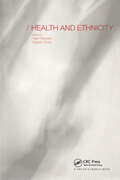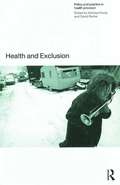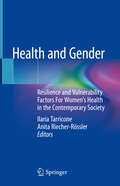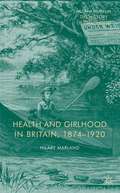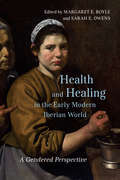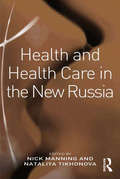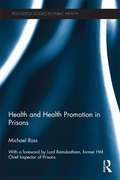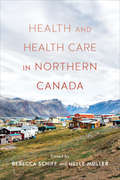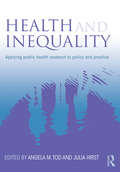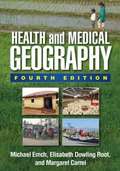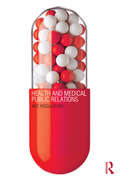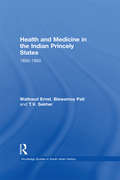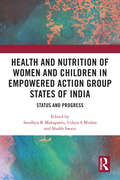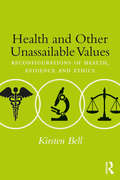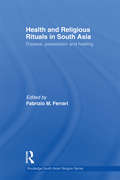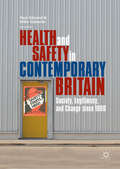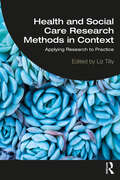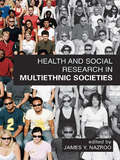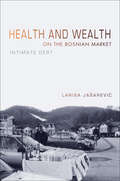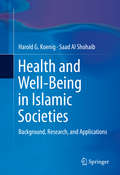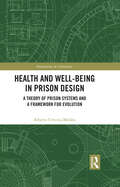- Table View
- List View
Health and Ethnicity
by Prakash Shetty Helen MacbethIn modern multicultural societies, the topic of 'health and ethnicity' has become increasingly recognised as highly relevant. All too frequently, academic coverage of the topic has been scattered in specialist literature of different disciplines; a book bringing these perspectives together has so far been lacking.The aim of the book is to explain the diversity in health experience due to determinants and factors that can be described as 'ethnic'. Both 'ethnicity' and 'health' are words that have stimulated semantic debate, and yet too seldom is sufficient sensitivity given over to the complexity of the issue.
Health and Exclusion: Policy and Practice in Health Provision
by David Banks Michael PurdyHealth and Exclusion is a pioneering examination of those policies and practices of exclusion currently experienced by health 'customers' in the UK. Chapters document examples of exclusion in a number of controversial areas, including: *the impact of poverty on the health of children *exclusion in maternity care *exclusion of those with mental health problems *exclusion of the elderly in health care *the silenced voice of the patient *barriers to recruitment and advancement within the health professions. The authors challenge whether New Labour policies sufficiently address the inequalities in health experienced by some sectors of society. Moreover they suggest that health professionals at times actively contribute to exclusion and suggest strategies and practices to combat marginalisation and resist exclusion.
Health and Gender: Resilience and Vulnerability Factors For Women's Health in the Contemporary Society
by Anita Riecher-Rössler Ilaria TarriconeThis book presents a concise and comprehensive overview of the most important protective and risk factors for women's health, and reviews the main areas of medical science from a gender perspective. Numerous scientific experiments and studies have shown how gender differences significantly affect the clinical presentation of physical and mental health disorders as well as responses to treatments. This text highlights these issues, while at the same time reflecting on the practical implications of the theoretical knowledge presented. It also examines the organization of social and health services, which should increasingly take into account the specificities related to gender differences and where equality is based on truly embracing these differences. The final part provides insights into the experiences and testimonies collected by the authors of the book. Written by a multidisciplinary team of medical, psychosocial and humanities professionals, this book is of interest to health professionals and medical students.
Health and Girlhood in Britain, 1874-1920
by Hilary MarlandThis first major study of girls' health in modern Britain explores how debates and advice on healthy girlhood shaped ideas about the lives of young women from the 1870s to the 1920s, as theories concerning the biological limitations of female adolescence were challenged and girls moved into new arenas in the workplace, sport and recreation.
Health and Healing in the Early Modern Iberian World: A Gendered Perspective (Toronto Iberic)
by Sarah E. Owens Margaret E. BoyleRecognizing the variety of health experiences across geographical borders, Health and Healing in the Early Modern Iberian World interrogates the concepts of "health" and "healing" between 1500 and 1800. Through an interdisciplinary approach to medical history, gender history, and the literature and culture of the early modern Atlantic World, this collection of essays points to the ways in which the practice of medicine, the delivery of healthcare, and the experiences of disease and health are gendered. The contributors explore how the medical profession sought to exert its power over patients, determining standards that impacted conceptions of self and body, and at the same time, how this influence was mediated. Using a range of sources, the essays reveal the multiple and sometimes contradictory ways that early modern health discourse intersected with gender and sexuality, as well as its ties to interconnected ethical, racial, and class-driven concerns. Health and Healing in the Early Modern Iberian World breaks new ground through its systematic focus on gender and sexuality as they relate to the delivery of healthcare, the practice of medicine, and the experiences of health and healing across early modern Spain and colonial Latin America.
Health and Health Care in the New Russia
by Nataliya TikhonovaThis volume explores the nature of health and health-care experiences in Russia by comparing societies and communities with different socio-cultural conditions. The unique use of longitudinal data collected over ten years, allows the authors to address key questions on Russians individual experiences of health care and their understanding of its influencing factors. They explore the methods of self treatment and illness prevention in combination with the effects poverty and treatment availability can have on the standards of living for the people surveyed. This pertinent issue follows a time of rapidly worsening health status amongst the Russian population and a grave decline in male life expectancy. The findings are set within the context of experience from Finland and the UK, allowing the authors to explore the challenge of the Russian health-care crisis to Western European models of health status and health care.
Health and Health Promotion in Prisons
by Michael RossThe impact of the United Nations "Healthy Prisons" initiative has highlighted the importance of health and health promotion in incarcerated populations. This invaluable book discusses the many health and medical issues that arise or are introduced into prisons from the perspective of both inmates and prison staff. Health and Health Promotion in Prison places key issues in prison healthcare into a historical perspective and investigates contemporary policy drivers. It then addresses the significant legal issues relating to health in prison settings and the human rights implications and questions that arise. The book presents a useful framework for health education in prison and a model for introducing structural, policy and health-related changes based on the UN Health in Prisons model, and also includes a special chapter on mental health issues. Providing a comprehensive and thought-provoking overview of health promotion issues in correctional environments, this is an essential reference for all those involved in prison healthcare.
Health and Healthcare Policy in Italy since 1861: A Comparative Approach
by Francesco TaroniProviding a historical overview of healthcare in Italy from its unification in 1861 to the present COVID-19 pandemic, this book analyses the political, social and cultural impact of Italian healthcare policy and medicine. The author examines the development of public health, hospitals, and primary care, and the building of healthcare systems across three political regimes in Italy: the liberal period (1861-1914), Fascism (1922-43), and the Italian Republic (1948 to the present day). By emphasising the embeddedness of health-related legislation in Italy’s political and social background, this book offers a comparative account of Italian health policy, and contrasts this with developments in neighbouring European countries, Canada and the United States. The book focuses on the Italian government’s reaction to the social and political impact of several diseases: pellagra; cholera; malaria; and tuberculosis, and explores the present-day response to the current COVID-19 pandemic. A timely and comprehensive read, this book will appeal to those teaching and researching Italian history and the history of medicine and healthcare more widely.
Health and Healthcare in Northern Canada
by Rebecca Schiff and Helle MøllerAccounting for almost two-thirds of the country’s land mass, northern Canada is a vast region, host to rich natural resources and a diverse cultural heritage shared across Indigenous and non-Indigenous residents. In this book, the authors analyse health and health care in northern Canada from a perspective that acknowledges the unique strengths, resilience, and innovation of northerners, while also addressing the challenges aggravated by contemporary manifestations of colonialism. Old and new forms of colonial programs and policies continue to create health and health care disparities in the North. Written by individuals who live in and study the region, Health and Health Care in Northern Canada utilizes case studies, interviews, photographs, and more, to highlight the lived experiences of northerners and the primary health issues that they face. In order to maintain resilience, improve the positive outcomes of health determinants, and diminish negative stereotypes, we must ensure that northerners – and their cultures, values, strengths, and leadership – are at the centre of the ongoing work to achieve social justice and health equity.
Health and Inequality: Applying Public Health Research to Policy and Practice
by Angela M. Tod Julia HirstHow can research on the social determinants of health be translated into real life public health practice? Challenging the research-practice gap, this text shows readers from a range of professions how their practice can help to minimise health inequalities. The social model of health embraces individual lifestyles, social and community networks, socio-economic, political and cultural influences and the plethora of factors that can impact on public health, for instance, education, work, welfare benefits, environment, housing, health and social care. All of these can have a significant effect on people’s experiences of health and well-being, and are often unrecognised sources of health inequalities. This innovative textbook outlines and discusses key public health principles and the social model of health. Drawing on a range of case studies and the international literature, it looks at how public health research has been applied to policy and practice. The book discusses the transferability that these findings have had and their capacity to influence and provide evidence for practice. Health and Inequality covers a broad range of social determinants of health, encountered throughout the life-course, including: Pre-birth and early years Breastfeeding and teenage mothers Health inequalities for mothers and babies in prison Children in full time education Sexuality, relationships and sexual health of young people Early adulthood Welfare rights and health benefits Women, employment and well-being Adults in later life Practical and clearly structured, this text will be useful to a range of health and social care professionals involved in public health work, particularly those undertaking courses on public health, health promotion or the social determinants of health.
Health and Medical Geography, Fourth Edition
by Elisabeth Dowling Root Margaret Carrel Michael EmchWhy are rainfall, carcinogens, and primary care physicians distributed unevenly over space? The fourth edition of the leading text in the field has been updated and reorganized to cover the latest developments in disease ecology and health promotion across the globe. The book accessibly introduces the core questions and perspectives of health and medical geography and presents cutting-edge techniques of mapping and spatial analysis. It explores the intersecting genetic, ecological, behavioral, cultural, and socioeconomic processes that underlie patterns of health and disease in particular places, including how new diseases and epidemics emerge. Geographic dimensions of health care access and service provision are addressed. More than 100 figures include 16 color plates; most are available as PowerPoint slides at the companion website. New to This Edition: *Chapters on the political ecology of health; emerging infectious diseases and landscape genetics; food, diet, and nutrition; and urban health. *Coverage of Middle East respiratory syndrome, Ebola, and Zika; impacts on health of global climate change; contaminated water crises in economically developed countries, including in Flint, Michigan; China's rapid industrial growth; and other timely topics. *Updated throughout with current data and concepts plus advances in GIS. *A range of pedagogical features. Pedagogical Features: *End-of-chapter review questions and suggestions for further reading. *Section Introductions that describe each chapter. *"Quick Reviews"--within-chapter recaps of key concepts. *Bold-faced key terms and an end-of-book glossary.
Health and Medical Public Relations
by Myc RiggulsfordHealth and Medical Public Relations takes a fresh look at media relations and news values. It examines how information about medical research from the academic, pharmaceutical and charitable sectors is disseminated to target audiences through a variety of PR techniques. Scrutinising a wide range of health-related public relations activities, the book combines a critical, analytical and cultural overview of these methods with helpful guidance on their practical application. Key features include: Advice on how to write and place effective press releases, plan and budget for campaigns, and anticipate responses from different sectors and the wider public Coverage of different types of communication and consultancy, including the controversial areas of lobbying and access to influential policy makers Case studies on the way in which experienced journalists and public relations practitioners gain coverage for their work, with plentiful examples drawn from both recent media scares and long-running issues A survey of the way challenging public relations issues have been perceived in the past, analysing the attitudes of both legislators and the public A user-friendly format designed to reinforce learning, including handy tips, definition boxes explaining key words and concepts, and exercises and reflection points to stimulate group discussion and reflection on specific examples of science and medical PR practice. Wide-ranging and highly accessible, this book will be an essential resource for undergraduates, postgraduates and professionals learning to specialise in health public relations.
Health and Medicine in the Indian Princely States: 1850-1950 (Routledge Studies in South Asian History)
by Waltraud Ernst Biswamoy Pati T.V. SekherSince the 1980s there has been a continual engagement with the history and the place of western medicine in colonial settings and non-western societies. In relation to South Asia, research on the role of medicine has focussed primarily on regions under direct British administration. This book looks at the ‘princely states’ that made up about two fifths of the subcontinent. Two comparatively large states, Mysore and Travancore – usually considered as ‘progressive’ and ‘enlightened’ – and some of the princely states of Orissa – often described as ‘backward’ and ‘despotic’ – have been selected for analysis. The authors map developments in public health and psychiatry, the emergence of specialised medical institutions, the influence of western medicine on indigenous medical communities and their patients and the interaction between them. Exploring contentious issues currently debated in the existing scholarship on medicine in British India and other colonies, this book covers the ‘indigenisation’ of health services; the inter-relationship of colonial and indigenous paradigms of medical practice; the impact of specific political and administrative events and changes on health policies. The book also analyses British medical policies and the Indian reactions and initiatives they evoked in different Indian states. It offers new insights into the interplay of local adaptations with global exchanges between different national schools of thought in the formation of what is often vaguely, and all too simply, referred to as 'western' or 'colonial' medicine. A pioneering study of health and medicine in the princely states of India, it provides a balanced appraisal of the role of medicine during the colonial era. It will be of interest to students and academics studying South Asian and imperial and commonwealth history; the history of medicine; the sociology of health and healing; and medical anthropology, social policy, public health, and international politics.
Health and Medicine in the circum-Caribbean, 1800-1968 (Routledge Studies in the Social History of Medicine #Vol. 33)
by Steven Palmer David Wright Juanita De BarrosHealth and medicine in colonial environments is one of the newest areas in the history of medicine, but one in which the Caribbean is conspicuously absent. Yet the complex and fascinating history of the Caribbean, borne of the ways European colonialism combined with slavery, indentureship, migrant labour and plantation agriculture, led to the emergence of new social and cultural forms which are especially evident the area of health and medicine. The history of medical care in the Caribbean is also a history of the transfer of cultural practices from Africa and Asia, the process of creolization in the African and Asian diasporas, the perseverance of indigenous and popular medicine, and the emergence of distinct forms of western medical professionalism, science, and practice. This collection, which covers the French, Hispanic, Dutch, and British Caribbean, explores the cultural and social domains of medical experience and considers the dynamics and tensions of power. The chapters emphasize contestations over forms of medicalization and the controls of public health and address the politics of professionalization, not simply as an expression of colonial power but also of the power of a local elite against colonial or neo-colonial control. They pay particular attention to the significance of race and gender, focusing on such topics as conflicts over medical professionalization, control of women’s bodies and childbirth, and competition between ‘European’ and ‘Indigenous’ healers and healing practices. Employing a broad range of subjects and methodological approaches, this collection constitutes the first edited volume on the history of health and medicine in the circum-Caribbean region and is therefore required reading for anyone interested in the history of colonial and post-colonial medicine.
Health and Nutrition of Women and Children in Empowered Action Group States of India: Status and Progress
by Sandhya R Mahapatro, Udaya S Mishra and Shubh SwainThis book tracks the progress of maternal and child health (MCH)—part of SDG3—in empowered action group states in India. It lays bare regional disparities and unfolds a range of issues relating to inequalities in access to MCH services, complex dynamics behind poor nutrition, health expenditure and impoverishment, structural bottlenecks of health system that hinder effective implementation of programmes; best practices adopted for improving MNCH indicators and appropriate strategies required for more informed policy. The volume: Examines the changing features of health and nutrition of mothers, new-borns and children between pre and post National Rural Health Mission (NRHM) Studies reproductive health and well-being of mother and children Explores linkages between food, nutrition and health Examines the underlying factors determining poor health and nutrition Probes into health expenditure, their impoverishment and its bearing on access to maternal and child healthcare services Proposes strategic interventions to reduce maternal, neonatal and child mortality and improve nutritional status The volume will be of great interest to scholars and researchers of public health, especially maternal and child health specialists, gender studies, development studies and public policy.
Health and Other Unassailable Values: Reconfigurations of Health, Evidence and Ethics
by Kirsten BellHealth and Other Unassailable Values sets out to examine health as a core cultural value. Taking ‘health’, ‘evidence’ and ‘ethics’ as her primary themes, Bell explores the edifice that underpins contemporary conceptions of health and the transformations in how we understand it, assess it and enact it. Although health, evidence and ethics have always been important values, she demonstrates that the grounds upon which they are grasped today are radically different from how they were formulated in the past. Divided into three parts, Part I focuses on the rise of epidemiology, Part II examines the emergence of evidence-based medicine, and Part III explores the broader ethical turn in health and medicine. Through an examination of core concepts including health behaviour, the randomised controlled trial, informed consent and human rights, Bell illustrates the ways in which certain entrenched ideas and assumptions about how human beings think and act recur across a variety of settings. An array of topical case studies, including cigarette packaging legislation, the incorporation of male circumcision as an HIV prevention tool, cancer screening technologies and e-cigarettes, ground the arguments presented. Written in a clear and engaging style, this volume will be of interest to a wide range of scholars and students, especially those in medical anthropology, medical sociology and public health. Clear chapter delineations make the work easy to engage with at the individual chapter level as well as a whole.
Health and Religious Rituals in South Asia: Disease, Possession and Healing (Routledge South Asian Religion Series)
by Fabrizio M. FerrariDrawing on original fieldwork, this book develops a fresh methodological approach to the study of indigenous understandings of disease as possession, and looks at healing rituals in different South Asian cultural contexts. Contributors discuss the meaning of 'disease', 'possession' and 'healing' in relation to South Asian religions, including Hinduism, Islam, Buddhism and Sikhism, and how South Asians deal with the divine in order to negotiate health and wellbeing. The book goes on to look at goddesses, gods and spirits as a cause and remedy of a variety of diseases, a study that has proved significant to the ethics and politics of responding to health issues. It contributes to a consolidation and promotion of indigenous ways as a method of understanding physical and mental imbalances through diverse conceptions of the divine. Chapters offer a fascinating overview of healing rituals in South Asia and provide a full-length, sustained discussion of the interface between religion, ritual, and folklore. The book presents a fresh insight into studies of Asian Religion and the History of Medicine.
Health and Safety for Learning Disability Workers
by Alice BradleyIf you are working within the learning disability sector and studying for the QCF Diploma in Health and Social Care, you will find this book an invaluable resource in helping you to achieve the units on Health and Safety. You will find the book easy to navigate, with each chapter covering one of the learning outcomes within the unit. Each chapter begins with an example taken from real people's stories and lots of activities, photographs and other illustrations are included throughout the book so you can really get to grips with the subject.
Health and Safety in Contemporary Britain: Society, Legitimacy, And Change Since 1960
by Mike Esbester Paul AlmondThis book analyses the perceived legitimacy of health and safety in post-1960 British public life. Since 2010 health and safety has appeared to be in crisis, being attacked by press, politicians and public alike, but are these claims of crisis accurate? How have understandings of health and safety changed over the past 60 years? By exploring the history, culture, and operation of health and safety in contemporary Britain, this book provides a new assessment of an understudied, but surprisingly far-reaching, part of the British political and social landscape. Combining archival research with focus group, social survey and oral history testimony, the book examines the historical background to health and safety, how health and safety has been enacted in public and in the workplace, the impact of changing economic, occupational and social structures on the operation of health and safety, and the conflicts and interests that have shaped the area.
Health and Safety: A Breakdown
by Emily Witt&“Haunting . . . [Witt] writes with such cool precision.&”—Jennifer Szalai, New York Times "Witt elevates writing about altered states of consciousness to something akin to the most brilliant art criticism I&’ve ever read."—Jia Tolentino, bestselling author of Trick Mirror From the New Yorker staff writer and acclaimed author of Future Sex, a memoir about drugs, techno, and New York CityIn the summer of 2016, a divisive presidential election was underway, and a new breed of right-wing rage was on the rise. Emily Witt, who would soon publish her first book on sex in the digital age, had recently quit antidepressants for a more expansive world of psychedelic experimentation. From her apartment in Brooklyn, she began to catch glimpses of the clandestine nightlife scene thrumming around her.In Health and Safety, Witt charts her immersion into New York City&’s dance music underground. Emily would come to lead a double life. By day she worked as a journalist, covering gun violence, climate catastrophes, and the rallies of right-wing militias. And by night she pushed the limits of consciousness in hollowed-out office spaces and warehouses to music that sounded like the future. But no counterculture, no matter how utopian, could stave off the squalor of American politics and the cataclysm of 2020.Affectionate yet never sentimental, Health and Safety is a lament for a broken relationship, for a changed nightlife scene, and for New York City just before the fall. Sparing no one—least of all herself—Witt offers her life as a lens onto an era of American delirium and dissolution.
Health and Social Care Research Methods in Context: Applying Research to Practice
by Liz TillyThis is the first textbook to show how research using a range of qualitative and quantitative methods relates to improving health and social care practice. The book shows how different research approaches are undertaken in practice and the challenges and strengths of different methodologies, thus facilitating students to make informed decisions when choosing which to use in their own research projects. The eleven chapters are each structured around different research methods and include: A brief overview of the research and research question Identification and overview of the research approach and associated methods selected to answer this question The sample and recruitment, including issues and challenges Ethical concerns Practical issues in undertaking the research approach Links between the research process and findings to health and social care values Links to the full research study Further reading The book will be a required reading for all students of social work; social care; nursing; public health and health studies and particularly suitable for those on widening participation courses.
Health and Social Research in Multiethnic Societies
by James Y. NazrooThis volume presents a ready source of information on the methodological issues facing research on ethnicity, which is highly relevant to a wide variety of health, economic and social issues in modern societies. Straightforward in its approach and accessible to those who are not specialists in studies of ethnicity, Health and Social Research in Multiethnic Societies provides essential and clear guidance on appropriate methods. Topics covered include: approaches to conceptualizing ethnicity and understanding the context of ethnicity in modern societies ethical issues and the political context within which ethnicity research is conducted engagement with researched communities, and with users more broadly cultural competence in research practical issues faced by both qualitative and quantitative research use of secondary and administrative data sources for research. Using a combination of critical analysis and case studies to illustrate the benefits and pitfalls of particular approaches, this volume provides access to core issues relevant to research with ethnic minority groups. It is a vital resource for those carrying out, and using, what is a considerable body of research, including students, academics, researchers, and research commissioners.
Health and Wealth on the Bosnian Market: Intimate Debt
by Larisa JašarevicLarisa Jasarevic offers an unforgettable look at the everyday experiences of people living in post-socialist, post-war Bosnia. Not at all existing on the world's margins, Bosnians today are concerned with the good life and are as entangled in consumer debt as everyone else. The insecurities of living in an economy dominated by informal networks of trade, personal credit, and indebtedness are experienced by Bosnians in terms of physical ailments, some not recognized by Western medical science. Jasarevic follows ordinary Bosnians in their search for treatment—from use of pharmaceuticals to alternative medicines and folk healers of various kinds. Financial well-being and health are woven together for Bosnians, and Jasarevic adeptly traces the links between the two realms. In the process, she addresses a number of themes that have been important in studies of life under neoliberalism in other parts of the world.
Health and Well-Being in Islamic Societies
by Harold G. Koenig Saad Al ShohaibFrom the first hospitals to pioneering pharmacy techniques, the early history of medicine reflects the groundbreaking contributions of Islamic physicians and scientists. Less recognized, however, is the impact of Islam on the health and daily health practices of modern day Muslims. Meticulously documented with current research sources and relevant religious texts, Health and Well-Being in Islamic Societies sheds light on the relationships between Muslim beliefs and physical, psychological, and social health. Background chapters trace Muslim thought on health and healing as it has evolved over the centuries to the present. The authors provide even-handed comparisons with Christianity as the two traditions approach medical and ethical questions, and with Christian populations in terms of health outcomes, assuring coverage that is not only objective but also empirically sound and clinically useful. And as the concluding chapters show, understanding of these similarities and differences can lead to better care for clients, cost-effective services for communities, and healthier Muslim populations in general. Included among the book's topics: Muslim beliefs about health, healing, and healthcare Similarities and differences between Muslim and Christian health beliefs Impact of religion on physical, mental, and community health in Muslims Understanding how Islam influences health Applications for clinical practice Implications for public health Cultural awareness is critical to improving both individual client health and public health on a global scale. Health and Well-Being in Islamic Societies is essential reading for clinical and health psychologists, psychiatrists, social workers, and nurses, and will be informative for the general reader as well.
Health and Well-Being in Prison Design: A Theory of Prison Systems and a Framework for Evolution (Innovations in Corrections)
by Alberto Urrutia-MoldesThis book establishes a new framework for prison design to promote the health and well-being of all prison users. Based on international research in Norway, Finland, the US and Chile, and drawing on the expertise of key International Advisors, this book uniquely reveals the perspectives of both designers and prison authorities concerning well-being in prison architecture. It is the first book to compare perspectives between prison models while providing essential guidance for the design of prison environments to promote the rehabilitation of inmates and their desistance from crime. The promotion of health and well-being of people in prison is vital to enable rehabilitation. Traditional prison architecture severely weakens both rehabilitation efforts and opportunities for desistance. Only a handful of prison systems in the world have shown significant changes in their prison designs. Underpinned by Critical Realism and the PERMA theory of well-being, this book reveals significant new insights to inform prison design. The author presents international case study research with interviews with prison authorities and designers from four countries and the three different prison models, as well as key international United Nations advisors. For the first time the visions of prison designers are contrasted with those of prison authorities, bringing a new synthesised understanding of the differences and similarities in their approach to the health and well-being of both inmates and staff from which to generate a new framework for design considerations. This book illuminates new directions for prison design and is essential reading for policymakers, academics, and students involved in the study and development of criminology, corrections, and penology. It is also an indispensable source of up-to-date knowledge for prison authorities, public health officials, architects, and designers involved in the design of prisons and any other type of coercive detention facilities.
